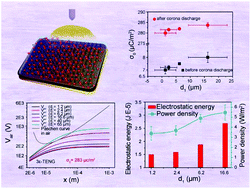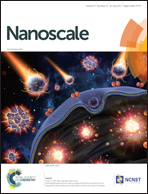A multi-dielectric-layered triboelectric nanogenerator as energized by corona discharge†
Abstract
Triboelectric nanogenerators (TENGs) have been invented recently for meeting the power requirements of small electronics and potentially solving the worldwide energy crisis. Here, we developed a vertical contact-separation mode TENG based on a novel multi-dielectric-layered (MDL) structure, which was comprised of parylene C, polyimide and SiO2 films. By using the corona discharge approach, the surface charge density was enhanced to as high as 283 μC m−2, and especially the open-circuit voltage could be increased by a factor of 55 compared with the original value. Furthermore, the theoretical models were built to reveal the output characteristics and store the electrostatic energy of the TENG. The influences of the structural parameters and operation conditions including the effective dielectric thickness, dielectric constant, gap distance and air breakdown voltage were investigated systematically. It was found that the output performances such as the peak voltage and power density are approximately proportional to the thickness of the MDL film, but they would be restricted by the air breakdown voltage. These unique structures and models could be used to deepen the understanding of the fundamental mechanism of TENGs, and serve as an important guide for designing high performance TENGs.



 Please wait while we load your content...
Please wait while we load your content...